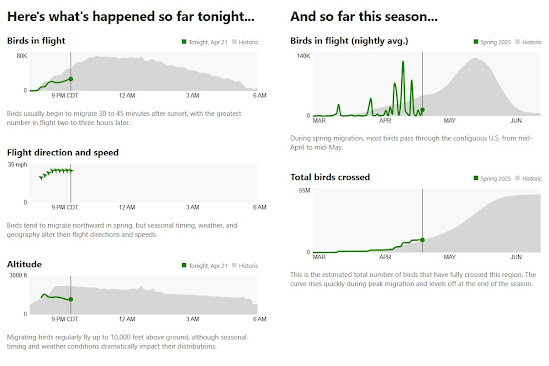 |
| Birdcast -The Cornell Lab |
You may have noticed in the April "Let's Get Hiking and Learning" post, that there were quite a few bird related hiking and learning opportunities. Hold onto your hats though - the May events post publishing on April 25 is chockfull of even more Driftless guided bird-related events sponsored by multiple organizations and agencies. They are ready to celebrate the great spring bird migrations with you!
What's the timing on this migration?
The early arrival of robins, red-winged blackbirds and grackles in March prepares us for the massive influx of songbirds arriving again to nest here or to continue to nesting grounds further north. April is the month that songbird migration really begins to build. New arrivals pop up every day.
Who doesn't love being outdoors and recognizing the song of a newly returned -or migrating through -meadowlark, Eastern phoebe, Eastern towhee, ruby- and gold-crowned kinglet and the always amazing variety of warbler songs? These returns heat up in April and continue to swell into May and June.
Most of the migration occurs at night. This information and so much more is available on Birdcast . If you haven't used this website yet, I highly recommend it.
The Cornell Lab, Colorado State University, UMassAmherst and a host of partners developed Birdcast, a bird migration online mapping tool and dashboard. It's an amazing online tool to help you not just access live daily forecast across the U.S. of migrating birds through June 15, but also see localized updates of your area (based on NOAA radar stations data).
Below is a chart of La Crosse WI action on April 21, 2025. The page also includes the predicted species of birds migrating through the area and also the numbers of birds as the night goes on and migration heats up. Data is updated every 6 hours.
If you haven't used The Cornell Lab's Birdcast website yet, I highly recommend it. It can deepen your understanding and appreciation of the birds that fill up the spring woods and soundscape around you.

No comments:
Post a Comment